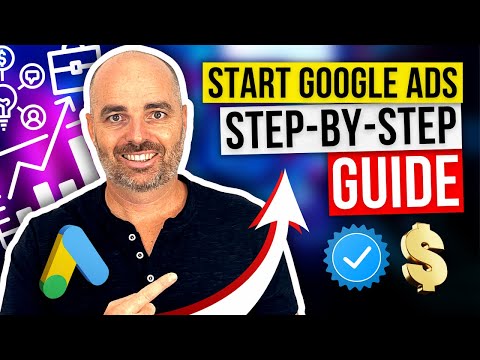Setting Up Your First Google Ads Campaign: A Step-by-Step Guide

Ready to unlock a floodgate of potential customers with Google Ads but feeling a bit overwhelmed about where to start? You’re not alone. Navigating the world of online advertising can seem daunting, especially if you’re venturing into it for the first time.
But worry not! In this guide, we’ll walk you through each step of setting up your first Google Ads campaign. From defining your goals to monitoring your progress, you’ll learn how to create an ad that reaches your target audience effectively.
Whether you’re a small business owner looking to expand your reach or an eager marketer ready to make a splash, this guide will equip you with the tools and confidence to launch your campaign with ease. Let’s dive in and turn clicks into customers!
Understanding the Basics of Google Ads
Before diving into your first campaign, it’s essential to grasp what Google Ads is all about. At its core, Google Ads is an online advertising platform designed to help businesses reach their target audience effectively. With over 3.5 billion search queries per day, Google is a powerhouse for connecting you with potential customers.
Google Ads operates on a pay-per-click (PPC) model, meaning you only pay when someone clicks on your ad. This is cost-effective because your budget is spent on tangible interactions, not just impressions. Remember, the goal is to attract clicks from people likely to convert into customers.
The beauty of Google Ads lies in its ability to target specific groups. You can customize your ads based on keywords, location, demographics, and even the time of day. This ensures that your ad appears to the right people at the right time.
Not only that, but, Google Ads offers a range of formats, from search ads that appear at the top of search results to display ads on partner websites. Each format has its advantages, depending on your campaign goals.
Understanding these basics will set the stage for creating a compelling campaign that drives results and amplifies your business’s reach.
Selecting the Right Keywords for Your Campaign
Choosing the right keywords is the cornerstone of a successful Google Ads campaign. Keywords are the phrases potential customers use when searching for products or services like yours, and getting them right can make all the difference.
Start by brainstorming a list of terms related to your business. Think like your customer—what words would they use? Once you have a solid list, use tools like Google’s Keyword Planner to expand upon those ideas and gather data on search volumes and trends.
Prioritize Relevance and Specificity
Focus on keywords that are highly relevant to your business. Generic terms might attract more clicks, but specific, long-tail keywords often yield better results because they capture searchers with clearer intent. For example, "vegan chocolate chip cookies" is more targeted than just "cookies."
Consider competition and cost too. Highly competitive keywords can be expensive and difficult to rank for, especially if your budget is limited. Aim for a balance: opt for keywords with a decent search volume but moderate competition.
Remember, keyword research isn’t a one-time task. Monitor their performance and be open to adjusting your list as you gather more insights from your campaigns. A little flexibility can lead to big improvements in reaching the right audience.

Creating Compelling Ad Copy
With your keywords in hand, it’s time to craft ad copy that grabs attention and drives action. Your ad copy is the face of your campaign—it’s what users see first, so make it count!
The key to successful ad copy is relevance and clarity. Ensure your text reflects the search intent behind your chosen keywords. Use language your audience relates to, clearly highlighting the benefits of your product or service.
The Power of a Strong Call to Action
A compelling call to action (CTA) is crucial. Whether it’s "Shop Now," "Get a Free Quote," or "Sign Up Today," a strong CTA gives clear direction and encourages users to take the next step.
Keep your headlines catchy and punchy. They should succinctly convey what you’re offering and why customers should care. Remember, you have limited space, so every word matters—make them impactful.
Don’t overlook your display URL. It’s another space to reinforce your message and can enhance your credibility. Customize it to include keywords or reflect your business line, adding another layer of persuasion.
Testing different versions of your ad copy can also provide insights into what resonates most with your audience. Regular refinement based on performance data will keep your ads fresh and effective.
Setting Up Conversion Tracking
To truly understand the impact of your Google Ads campaign, setting up conversion tracking is essential. This tool helps you track valuable actions on your website, such as purchases, sign-ups, or any goal-specific actions, thus providing insights into what’s working and what needs improvement.
Start by defining what a "conversion" means for your business. It could be a completed contact form, a product purchase, or even a newsletter subscription. Once identified, you can set up conversion tracking in your Google Ads account.
Google provides a handy conversion tracking code, which you’ll need to add to the pages where conversions occur—think order confirmation or thank you pages. This snippet of code communicates with Google Ads, reporting when users who’ve interacted with your ad take the desired action.
By analyzing this data, you can see which keywords and ads are driving conversions. This information is powerful, allowing you to adjust bids, tweak ad copy, or refine targeting to boost performance.
Remember, conversion tracking isn’t just a one-time setup; it’s a continuous process. Regularly reviewing and optimizing based on your findings is crucial for maximizing your return on investment and continuously improving your campaigns.
Optimizing Your Campaign for Performance
You’ve launched your Google Ads campaign—great! Now, the real work begins. Optimization is key to transforming good campaigns into great ones and ensuring your advertising dollars are well spent.
First, dive into the data. Look at which ads, keywords, and targeting strategies are delivering the highest returns. This insight allows you to allocate budget more effectively and refine underperforming elements.
Adjust your bids based on performance. If certain keywords are delivering conversions at a lower cost, consider increasing bids to gain more visibility. Conversely, pull back on high-cost, low-return keywords to optimize your budget.
Ad copy is another area ripe for experimentation. Test different headlines, descriptions, and CTAs to see what resonates best with your audience. Regular A/B testing can uncover new ways to engage potential customers.
Targeting can also benefit from fine-tuning. Use demographic data and location insights to focus on users most likely to convert. Narrowing or expanding your audience based on performance metrics can significantly enhance results.
Finally, stay adaptable. The digital landscape is ever-changing, and keeping your campaigns aligned with current trends and user behaviors is critical. Continuously tweaking and improving your strategy will ensure sustained success.
The Bottom Line: Monitoring and Adjusting Your Campaign
Now that your Google Ads campaign is up and running, the journey doesn’t stop here. The true power of digital advertising is found in its flexibility, allowing you to adapt your strategy based on real-time data.
Regular monitoring is crucial. Keep a close eye on your campaign metrics—click-through rates, conversion rates, and cost-per-conversion are key indicators of success. These statistics offer a clear view of what’s working and what isn’t.
Adjusting your strategy based on these insights is where you gain a competitive edge. Don’t hesitate to pause underperforming ads or campaigns, while investing more in those showing promise. Optimization isn’t a one-time task; it’s an ongoing process of fine-tuning and refinement.
Also, remember the importance of market trends and consumer behavior. As these evolve, so should your campaigns. Whether it’s shifting audience preferences or seasonal changes in demand, being responsive ensures your ads remain relevant.
On top of that, take advantage of Google’s built-in tools like automated bidding and remarketing options. These features can enhance your campaign’s effectiveness without extensive manual effort.
In conclusion, the success of a Google Ads campaign hinges on diligent monitoring and the willingness to adjust your approach. By staying proactive, you can ensure your advertising efforts are consistently aligned with business goals, driving meaningful results and maximizing your return on investment. The digital landscape is dynamic, and your campaign’s adaptability will be its strongest asset in achieving long-term success.



